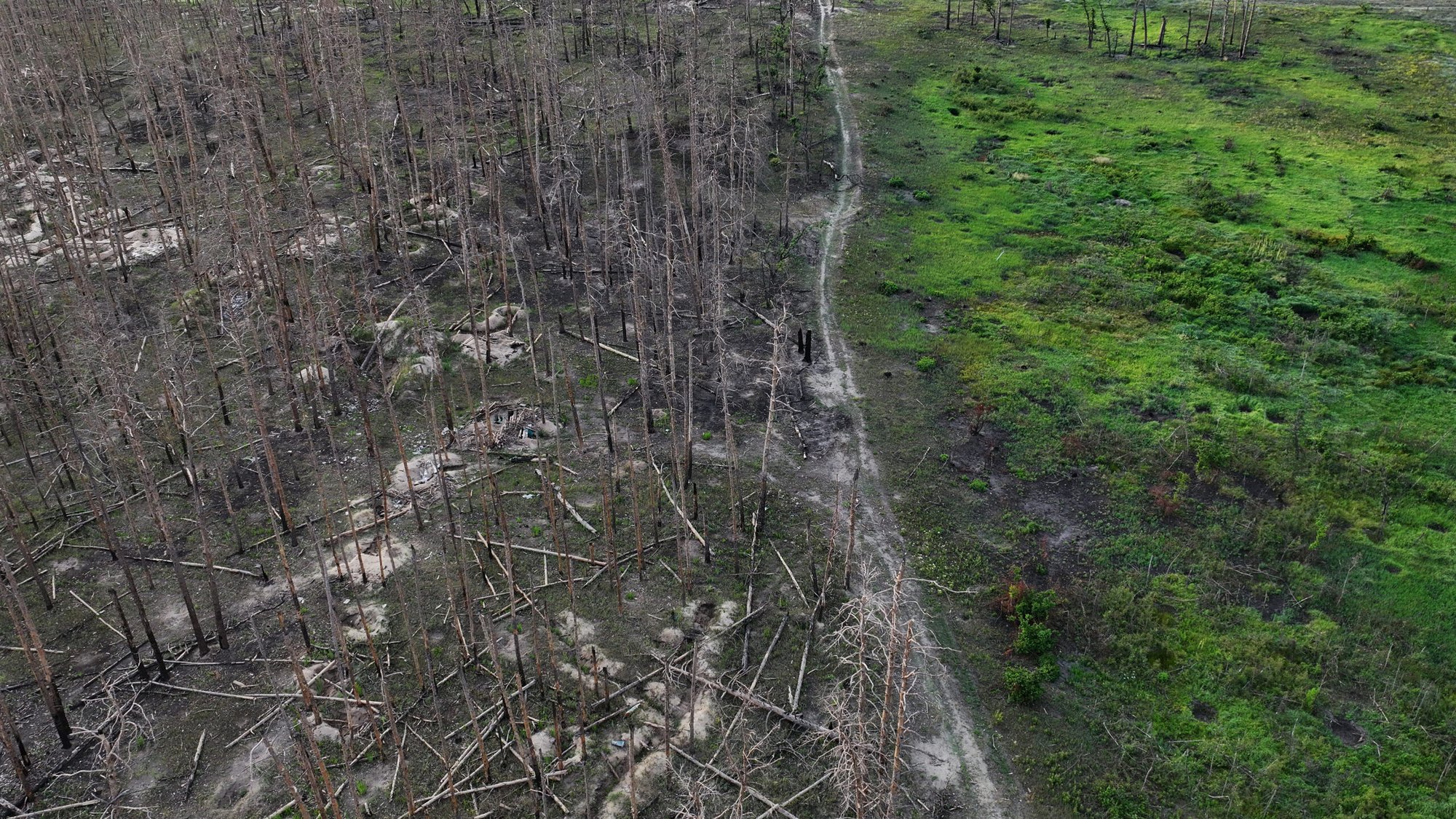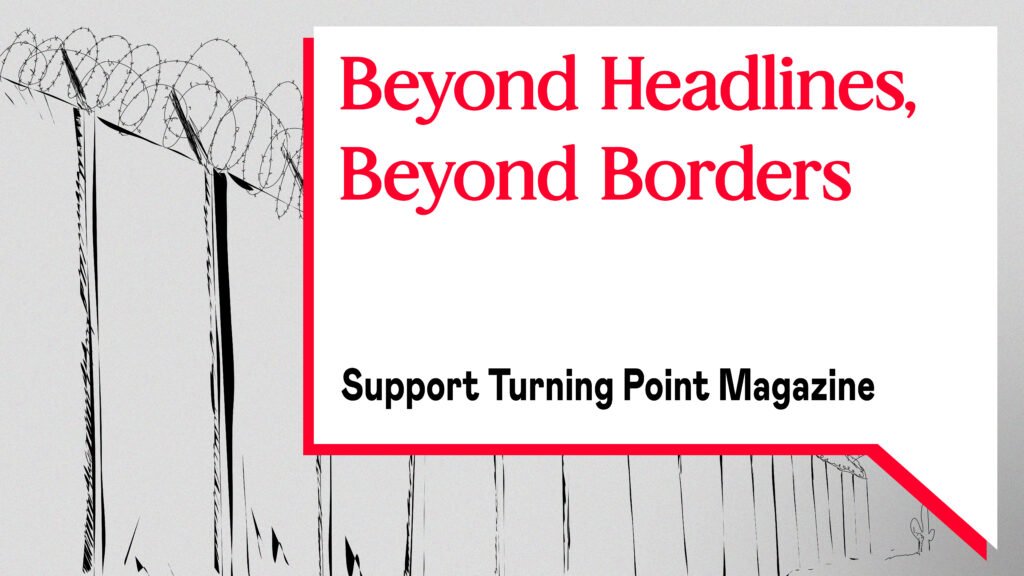Cover photo: June 23, 2024, Serebrianka forest, Donbas, Ukraine – Drone image of the nicknamed Black Forest near Kreminna. Partly under Russian occupation, the forest is scarred by heavy shelling and littered with mines. Split between Ukrainian and Russian control, it has seen intense fighting for two years. Once a vibrant wildlife reserve, it now lies silent, its natural sounds replaced by the noise of conflict. © Gaelle Girbes
As the world stumbles into the middle of the 2020s, the Doomsday Clock strikes an ominous 90 seconds to midnight. Two factors stand out as the driving forces behind its grim outlook: conflict and environment. The World Economic Forum’s latest Global Risks Report predicts this “duo of dangerous crises” to also define the foreseeable future, with almost two-thirds of the survey respondents expecting a “turbulent” or “stormy” decade ahead. The report projects climate change and conflicts to set the stage for other global cataclysms: ranging from migration and food insecurity to living costs crises and competition over resources. At the societal level, these developments unfold amid an “increasingly palpable sense of frustration” at the status quo and polarization of the global order.
The year 2023 was the hottest on record. The rising frequency of floods, heatwaves, wildfires, hurricanes and countless other natural disasters is breaking down the distinction between domestic and foreign politics—with questions of responsibility and accountability reverberating far beyond national borders. Policies around national security have come to encompass an ever-growing set of climate-related phenomena: from crisis management and disaster aid to securing strategic resources such as critical green transition minerals. At the same time, new border walls are erected and stricter controls are implemented as states try to confine the inherently transnational impact of environmental threats and wars—most notably global migration. Climate change alone is estimated to displace up to 1 billion people in the coming three decades, while armed conflicts is seen as the second main driver of involuntary migration.
As isolationist, conflict-prone, and militarized state responses testify, the “dangerous duo” of conflicts and climate change calls for a renewed internationalist consciousness to guide local and global struggles for justice, peace, and ecology. The time to move from internationalist ideas to internationalist actions is now. Navigating the dual global threats of armed conflict and climate catastrophe requires building bridges between geographically and socio-culturally diverse knowledge and experience. Besides taking action locally, there is a growing urgency to bring environmental, anti-militarist, and anti-imperialist forces into transnational alliances that could intervene through coordinated action on the global stage.
In the coming weeks, Turning Point will publish a series of articles exploring the intersection of conflict, militarism, and climate catastrophe. Two of our stories—looking at Kurdistan and Palestine, respectively—will investigate the question of ecocide: a phenomenon wherein the overlap between armed conflict and environmental destruction is witnessed most intensely.
The concept of ecocide has gained prominence over the past years amid increasing ecological consciousness and calls for legislation against environmental crimes. Coined in the early 1970s, ecocide was originally introduced as a juridical concept in an effort to hold the US accountable for the destruction of Vietnamese jungles with chemical agents. After genocide, crimes against humanity, war crimes, and the crime of aggression, ecocide was the fifth proposal to be included in what became later known as the Rome Statute, the founding treaty of the International Criminal Court, in 1998.
Although dropped from international jurisdiction thanks to the pressure of the West, several states have since included ecocide in their national legislation to penalize environmental crimes. While rightfully expanding the scope of ecocide beyond its purely militaristic origins, a narrow environmentalist and civilian understanding of the concept risks overlooking the concepts foundations in ecocidal warfare.
As Patrick Hilsman writes in his article about the war on Gaza, ecocide is not just environmental destruction but is inherently connected to the genocidal objectives of the Israeli occupation in Palestine. While air strikes have annihilated civilian infrastructure throughout the Gaza Strip, Hilsman sheds light on how the destruction of agricultural and ecology plays a key role in making Gaza uninhabitable in the short term.
A different form of ecocidal warfare has unfolded in neighboring Syria, where after 13 years of resistance, Assad’s dictatorial regime is still firmly in power. Henri Sulku reports on how Turkey has weaponized the country’s fragile environment in its low-intensity war against the de facto autonomous North-Eastern regions of Syria, better known as Rojava. In contrast to the ferocity of Israel’s current onslaught, the Turkish army is slowly but steadily undermining conditions of life through ecocidal warfare. This ecocide must be understood in light of the genocidal backdrop of the decades-old conflict between the Turkish state and the stateless Kurds who spearheaded efforts to establish regional autonomy in Syria.
Yet, outright ecocidal crimes are not the only ways in which militaries impact the environment. As Patrick Bigger succinctly points out, global militaries are responsible for about five percent of total carbon emissions. That is more than the emissions of entire countries, like Russia or Japan. And it is not only in contributing to the climate crisis that we ought to hold the military industrial complex to account. Exploring the consequences of increasingly militaristic responses to climate crises, Bigger illuminates the acute dangers of allowing the armed agents of the state a greater say in “crisis management.”
In her article, Beki McElvain investigates the militarization of crisis response through a case study of the Mexican city of Acapulco. Devastated by Hurricane Otis in October 2023, Acapulco was rapidly taken over by the Guardia Nacional (National Guard) which assumed a central role in the management of recovery resources and aid distribution. McElvain explores the role this militarization of care and crisis management plays in the ruling party’s austerity policies and their impending consequences for the long-term socio-economic and environmental landscape of the city.
As we explore how nature and agriculture fall victim to imperialist and colonialist crimes in Palestine and Kurdistan, and learn about the militarized response to natural disasters by the faux-leftist government in Mexico, the argument Bigger makes in his inaugural essay to this series resonates ever louder: the era of single-issue social movement organizing is over. If we don’t integrate a common, intersectional agenda in each of our struggles, we risk ceding ground to the reactionary forces in whose hands the Doomsday Clock will soon strike midnight.





